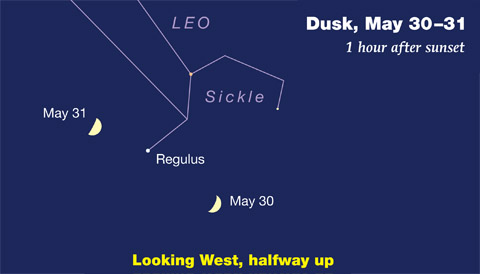Listen to May's astronomy podcast to learn why the Big Dipper is the "Swiss Army Knife" of the late-spring northern sky.
With the final vestiges of winter's constellations plunging from view in the west after sunset, it's time to enjoy a parade of late-spring stars. Start by spotting Jupiter, high in the south after sunset. Not far below it is Spica, the anchor star in Virgo, the Maiden. Way over in the northwest, look for Capella, which is bright but not very high above the horizon.

Sky & Telescope
About halfway in between is Regulus, the alpha star in the constellation Leo, the Lion. Regulus sits at the bottom of a star pattern called the Sickle, because it looks like the hand tool with a curved blade used for harvesting crops. Regulus is at the bottom of the handle. Or maybe you’ll see it more easily if you look for a question mark facing the wrong way.
High overhead, you should see the Big Dipper looming over you, with its curved handle bent upward and its four-sided bowl apparently overturned as if dumping soup into some imaginary pot. You can think of the Big Dipper as the "Swiss Army Knife of the Sky," because you can use its stars to find other key constellations and even Polaris, the North Star.
To learn all the ways the Big Dipper serves as a guidepost to other stars, listen to or download our monthly astronomy podcast below. It provides 7½-minute-long tour of the stars and planets that you'll see this month.
Podcast: Play in new window | Download
Subscribe: Apple Podcasts | Google Podcasts | Spotify | Email | RSS | More
 3
3
Comments
astronomer46
May 12, 2017 at 7:23 pm
Does the moon occult Regulus May30 - 31? If not, how close and at what time UTC will it be?
You must be logged in to post a comment.
[email protected]
May 16, 2017 at 6:12 am
My planetarium program says if it does occult it is during the day on the 31st in the USA.
You must be logged in to post a comment.
[email protected]
May 16, 2017 at 6:05 am
Hi Kelly! I was able to spot Mercury this morning from Orlando between 5:45am EDT and 6am EDT with no optical aids. It was pretty much due East about 10 degrees to 15 degrees above the horizon. Others maybe able to see it too this week.
You must be logged in to post a comment.
You must be logged in to post a comment.